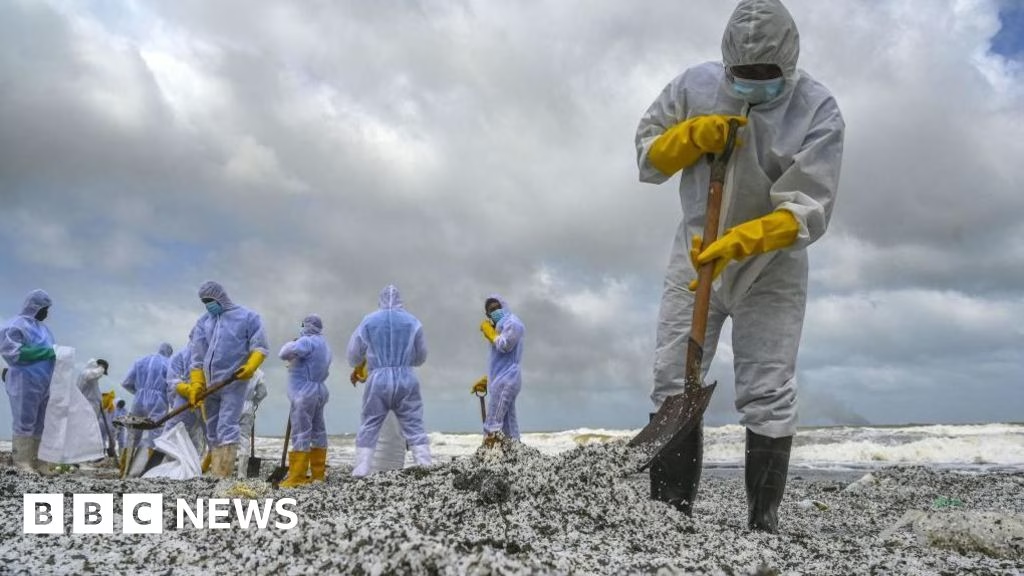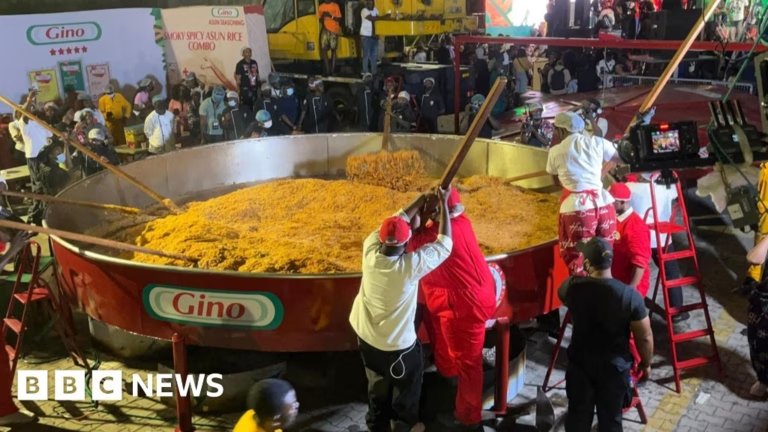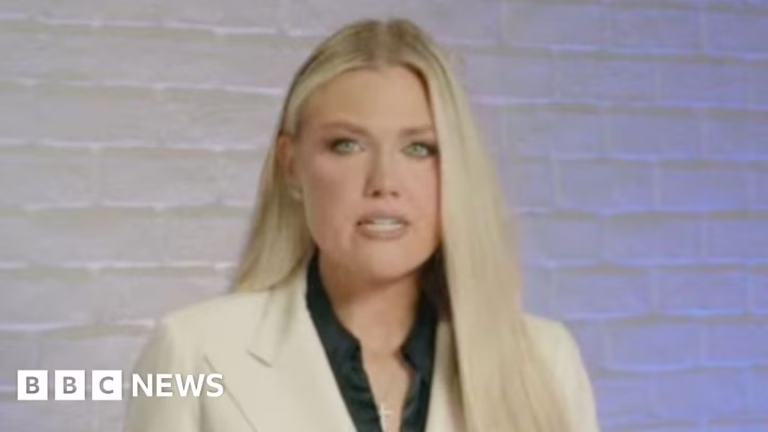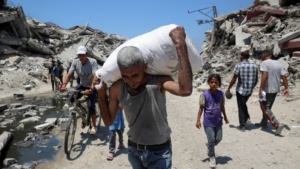<
div data-id=”” class=”sc-3b6b161a-0 dEGcKf”>
Four years after a stricken cargo ship caused the largest plastic spill ever recorded, volunteers on Sri Lanka’s beaches are still sifting kilograms of tiny, toxic plastic pellets from the sand.
Billions of plastic nurdles, as they are called, are thought to have washed up after the X-Press Pearl disaster in 2021, along with tonnes of engine fuel, acid, caustic soda, lead, copper slag, lithium batteries and epoxy resin – all toxic to aquatic life.
The immediate damage was obvious: the nurdles inundated the shoreline, turning it white, while dead turtles, dolphins and fish began washing up.
But scientists are now flagging fears the damage to the environment could be much more enduring than previously thought.
So far, hundreds of millions of nurdles may have been cleared away – but the remaining, lentil-sized microplastic granules have become increasingly difficult to find as they disappear deeper into the sand.
Worse, those pieces of plastic now appear to be becoming even more toxic, new research suggests.
“They seem to be accumulating pollution from the ocean,” said David Megson, of Manchester Metropolitan University. “Like a lovely big chemical sponge.”
Nurdles are the raw materials that are melted to make plastic products and it is not unusual for large amounts to be transported in the global plastic supply chain.
The problems onboard the X-Press Pearl started soon after setting sail from Dubai Port bound for Port Klang in Malaysia, when the crew noticed that a container carrying nitric acid was leaking, corroding the metal box. But they were denied permission to unload the smoking, leaking container at ports in Qatar and India.
The container had been leaking acid at a rate of about a litre an hour for at least eight days when it sailed into Sri Lankan waters late at night on 19 May 2021.
It had requested emergency berthing – but by the morning the Singapore-flagged vessel was alight.
Despite firefighting efforts from the crew, the Sri Lankan authorities and salvors, the fire spread throughout the ship.
Two weeks later, it sank, spilling its cargo and fuel into the sea around nine nautical miles off the country’s south-west coast, between the capital Colombo and Negombo to the north.
So far, hundreds of millions of nurdles may have been cleared away – but the remaining, lentil-sized microplastic granules have become increasingly difficult to find as they disappear deeper into the sand.
Worse, those pieces of plastic now appear to be becoming even more toxic, new research suggests.
“They seem to be accumulating pollution from the ocean,” said David Megson, of Manchester Metropolitan University. “Like a lovely big chemical sponge.”
Nurdles are the raw materials that are melted to make plastic products and it is not unusual for large amounts to be transported in the global plastic supply chain.
The problems onboard the X-Press Pearl started soon after setting sail from Dubai Port bound for Port Klang in Malaysia, when the crew noticed that a container carrying nitric acid was leaking, corroding the metal box. But they were denied permission to unload the smoking, leaking container at ports in Qatar and India.
The container had been leaking acid at a rate of about a litre an hour for at least eight days when it sailed into Sri Lankan waters late at night on 19 May 2021.
It had requested emergency berthing – but by the morning the Singapore-flagged vessel was alight.
Despite firefighting efforts from the crew, the Sri Lankan authorities and salvors, the fire spread throughout the ship.
Two weeks later, it sank, spilling its cargo and fuel into the sea around nine nautical miles off the country’s south-west coast, between the capital Colombo and Negombo to the north.
What happened next “was just like out of a war movie”, says Muditha Katuwawala, an environmentalist and founder of the Pearl Protectors, a local NGO that volunteered to help the clean-up operation, which was run largely by Sri Lankan state authorities with funding from the ship’s owners.
“We started seeing turtles getting washed up with similar sorts of traits… the skin had burn marks [and] was peeling off. The nose and eyes were red and puffed up, and we saw dolphins washing up and… their skin was peeling off and red,” Mr Katuwawala said.
The nurdles on the beaches were “like snow,” he says, adding that “it was horrifying”.
The clean-up began in earnest. At the start, Mr Katuwawala and his fellow volunteers “were collecting like 300-400 kilos of nurdles” each day.
Over time, it dropped to three to four kilograms in a couple of hours.
“The nurdles were getting more dispersed, it was harder to see them as they got buried in the sand over time.”
It was decided the cost-benefit ratio was no longer worth the effort of mobilising volunteers. The groups stood down, leaving the task to state-organised local clean-up groups.
At the same time, scientists were getting concerned about the possibility the plastic pellets – already harmful to animals which eat them accidentally – may be getting more toxic, contaminated from the spill, or from other pollution sources.
Over the ensuing years, they have collected samples which could help trace the effect over time.
So far, hundreds of millions of nurdles may have been cleared away – but the remaining, lentil-sized microplastic granules have become increasingly difficult to find as they disappear deeper into the sand.
Worse, those pieces of plastic now appear to be becoming even more toxic, new research suggests.
“They seem to be accumulating pollution from the ocean,” said David Megson, of Manchester Metropolitan University. “Like a lovely big chemical sponge.”
Nurdles are the raw materials that are melted to make plastic products and it is not unusual for large amounts to be transported in the global plastic supply chain.
The problems onboard the X-Press Pearl started soon after setting sail from Dubai Port bound for Port Klang in Malaysia, when the crew noticed that a container carrying nitric acid was leaking, corroding the metal box. But they were denied permission to unload the smoking, leaking container at ports in Qatar and India.
The container had been leaking acid at a rate of about a litre an hour for at least eight days when it sailed into Sri Lankan waters late at night on 19 May 2021.
It had requested emergency berthing – but by the morning the Singapore-flagged vessel was alight.
Despite firefighting efforts from the crew, the Sri Lankan authorities and salvors, the fire spread throughout the ship.
Two weeks later, it sank, spilling its cargo and fuel into the sea around nine nautical miles off the country’s south-west coast, between the capital Colombo and Negombo to the north.








